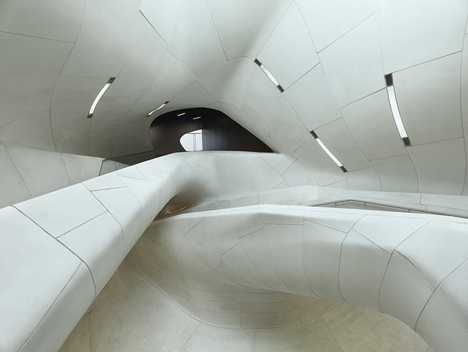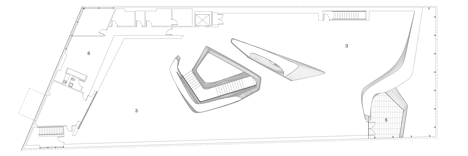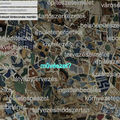
- forrás: dezeen.com;
- tervező: Trahan Architects
- Natchitoches, Louisiana

Az ismertetés helyett - olvasd el alant, angolul - válogatás a hozzászólásokból:
- A műkő látszó csatlakozása nekem emberibbé teszi – ha tökéletes lenne az illesztés, nem válna túl sterillé?
- Gyönyörű terv, tökéletes megvalósítással – szeretném végighúzni a kezem ezeken a hajlatokon!
- Az első parametrikus tervezésű épület aminek van értelme. A laza hajlatokat kell hogy ellenpontozza valami – ezek a srácok megcsinálták. Zaha, figyelj!
- Parametrikus lenne? Nem egyszerűen szobrászi?
- Egyetlen kérdésem, hogy hova kerül a kiállítás? Tartok tőle hogy ha nem ugyanilyen figyelemmel készül a kiállítás és annak a grafikai világa, ez a gyönyörű szobor sokat veszít majd a használat során.
- Hihetetlenül jól megcsinált ház. Nagyon érdekes a belső és a külső is. Láttam közeli fotókat is, és talán vannak kisebb csatlakozási pontatlanságok, de ilyesmit építeni a tipikusan fejlődésellenes délen – igazi siker.
- A belső Zahától, a külső Herzog & DeMeurontól lopva. A végeredmény mindenesetre nagyon szép.


The Louisiana State Museum and Sports Hall of Fame brings together two previously independent collections to create a combined exhibition for regional history and sport in the centre of the city.Rather than separating the exhibitions over two distinct floors, Trahan Architects designed a series of curving structural volumes that allow the three galleries to gently flow into one another.
"While sports and regional history may appeal to different audiences, the exhibits and configuration explore interconnections between the two," explained the architects.

"The spaces flow visually and physically together, configured to accommodate state-of-the-art exhibits, education and support functions," they added.

Using the fluid geometries of the nearby Cane River as a guide, the architects centred the spaces around a generous foyer that curves through the heart of the building, dividing two galleries on the lower level and leading to a third above.

The white stone surfaces can be used as screens for film projection, plus there's also a first-floor balcony overlooking the city square.

The museum's exterior envelope is a simple rectilinear volume, clad on all sides by pleated copper panels that form louvres.

"The louvred skin controls light, views and ventilation, animates the facade and employs surface articulation previously achieved by architectural ornamentation," said the architects.

The building was recently nominated for awards at both the World Architecture Festival and the Inside Festival, which took place in Singapore earlier this month.

Photography is by Tim Hursley.
Here's a project description from Trahan Architects:
Louisiana State Museum and Sports Hall of Fame
The Louisiana State Museum and Sports Hall of Fame in historic Natchitoches, Louisiana merges two contrasting collections formerly housed in a university coliseum and a nineteenth century courthouse, elevating the visitor experience for both. Set in the oldest settlement in the Louisiana Purchase on the banks of the Cane River Lake, the design mediates the dialogue between sports and history, past and future, container and contained.

Our exploration focuses on three questions. How does our design explore the client brief to exhibit sports and history simultaneously? How does it respond to the historic building fabric? How does it make a connection to context?

Our resolution is, first, to interpret athletics as a component of cultural history rather than as independent themes. While sports and regional history may appeal to different audiences, the exhibits and configuration explore interconnections between the two. The spaces flow visually and physically together, configured to accommodate state-of-the-art exhibits, education and support functions. Visitors however can experience both narratives either separately or simultaneously.

Second, historical pastiche is set aside in favour of a design language in response to the site. The internal organisation is an extension of the existing meandering urban circulation, while the design mediates the scale and character of the historic commercial core and adjacent residential neighbourhood. The "simple" exterior, clad with pleated copper panels, alluding to the shutters and clapboards of nearby plantations, contrasts with and complements the curvaceous interior within. The louvred skin controls light, views and ventilation, animates the facade, and employs surface articulation previously achieved by architectural ornamentation. The flowing interior emerges at the entrance, enticing visitors to leave the walking tour and into the evocative exhibit spaces within.

Third the design reflects the carving of the ancient river whose fluvial geomorphology inspired the dynamic interior form. The dynamic foyer is sculpted out of 1,100 cast stone panels, seamlessly integrating all systems and washed with natural light from above. The cool white stone references bousillage, the historic horse hair, earth and Spanish moss utilised by 17th Century settlers. The flowing surfaces reach into the galleries, serving as "screens" for film and display. At the climax of the upper level, the path arrives at a veranda overlooking the city square, sheltered by copper louvres, further connecting the interior to the public realm.






